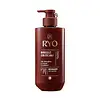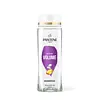What's inside
What's inside
 Key Ingredients
Key Ingredients

 Benefits
Benefits

 Concerns
Concerns

 Ingredients Side-by-side
Ingredients Side-by-side

Water
Skin ConditioningGlycerin
HumectantCetyl Alcohol
EmollientDipropylene Glycol
HumectantStearyl Alcohol
EmollientStearamidopropyl Dimethylamine
EmulsifyingDimethicone
EmollientLactic Acid
BufferingPhenoxyethanol
PreservativeParfum
MaskingEthylhexylglycerin
Skin ConditioningLinalool
PerfumingBenzyl Benzoate
AntimicrobialAlpha-Isomethyl Ionone
PerfumingHexyl Cinnamal
PerfumingAlcohol Denat.
AntimicrobialCaprylic/Capric Triglyceride
MaskingPanax Ginseng Root Extract
EmollientZingiber Officinale Root Extract
MaskingButylene Glycol
HumectantTocopherol
AntioxidantGanoderma Lucidum Extract
Skin ProtectingCyclodextrin
AbsorbentCarum Carvi Seed Extract
MaskingCamellia Seed Oil
Camellia Sinensis Seed Oil
HumectantPropanediol
SolventGlycyrrhiza Glabra Root Extract
BleachingGlycine Soja Seed Extract
Skin ConditioningXylitylglucoside
HumectantAnhydroxylitol
HumectantXylitol
HumectantCamellia Sinensis Leaf Extract
AntimicrobialSmilax China Bark Extract
Skin ConditioningNatto Gum
Hydroxypropyl Cyclodextrin
MaskingNelumbo Nucifera Extract
Skin ConditioningUlmus Davidiana Root Extract
Skin ConditioningRehmannia Elata Root Extract
Skin ProtectingGlucose
HumectantHoney
HumectantPyrus Malus Stem Extract
Skin ConditioningDisodium EDTA
1,2-Hexanediol
Skin ConditioningBacillus
Skin ConditioningCurcuma Longa Rhizome Extract
Skin ConditioningOryza Sativa Extract
AbsorbentWater, Glycerin, Cetyl Alcohol, Dipropylene Glycol, Stearyl Alcohol, Stearamidopropyl Dimethylamine, Dimethicone, Lactic Acid, Phenoxyethanol, Parfum, Ethylhexylglycerin, Linalool, Benzyl Benzoate, Alpha-Isomethyl Ionone, Hexyl Cinnamal, Alcohol Denat., Caprylic/Capric Triglyceride, Panax Ginseng Root Extract, Zingiber Officinale Root Extract, Butylene Glycol, Tocopherol, Ganoderma Lucidum Extract, Cyclodextrin, Carum Carvi Seed Extract, Camellia Seed Oil, Camellia Sinensis Seed Oil, Propanediol, Glycyrrhiza Glabra Root Extract, Glycine Soja Seed Extract, Xylitylglucoside, Anhydroxylitol, Xylitol, Camellia Sinensis Leaf Extract, Smilax China Bark Extract, Natto Gum, Hydroxypropyl Cyclodextrin, Nelumbo Nucifera Extract, Ulmus Davidiana Root Extract, Rehmannia Elata Root Extract, Glucose, Honey, Pyrus Malus Stem Extract, Disodium EDTA, 1,2-Hexanediol, Bacillus, Curcuma Longa Rhizome Extract, Oryza Sativa Extract
Water
Skin ConditioningSodium Lauryl Sulfate
CleansingSodium Laureth Sulfate
CleansingCocamidopropyl Betaine
CleansingSodium Citrate
BufferingSodium Chloride
MaskingSodium Xylenesulfonate
Parfum
MaskingCitric Acid
BufferingSodium Benzoate
MaskingHydroxypropyl Methylcellulose
Emulsion StabilisingTetrasodium EDTA
Histidine
HumectantPanthenol
Skin ConditioningPanthenyl Ethyl Ether
Methylchloroisothiazolinone
PreservativeMethylisothiazolinone
PreservativeWater, Sodium Lauryl Sulfate, Sodium Laureth Sulfate, Cocamidopropyl Betaine, Sodium Citrate, Sodium Chloride, Sodium Xylenesulfonate, Parfum, Citric Acid, Sodium Benzoate, Hydroxypropyl Methylcellulose, Tetrasodium EDTA, Histidine, Panthenol, Panthenyl Ethyl Ether, Methylchloroisothiazolinone, Methylisothiazolinone
 Reviews
Reviews

Ingredients Explained
These ingredients are found in both products.
Ingredients higher up in an ingredient list are typically present in a larger amount.
Parfum is a catch-all term for an ingredient or more that is used to give a scent to products.
Also called "fragrance", this ingredient can be a blend of hundreds of chemicals or plant oils. This means every product with "fragrance" or "parfum" in the ingredients list is a different mixture.
For instance, Habanolide is a proprietary trade name for a specific aroma chemical. When used as a fragrance ingredient in cosmetics, most aroma chemicals fall under the broad labeling category of “FRAGRANCE” or “PARFUM” according to EU and US regulations.
The term 'parfum' or 'fragrance' is not regulated in many countries. In many cases, it is up to the brand to define this term.
For instance, many brands choose to label themselves as "fragrance-free" because they are not using synthetic fragrances. However, their products may still contain ingredients such as essential oils that are considered a fragrance by INCI standards.
One example is Calendula flower extract. Calendula is an essential oil that still imparts a scent or 'fragrance'.
Depending on the blend, the ingredients in the mixture can cause allergies and sensitivities on the skin. Some ingredients that are known EU allergens include linalool and citronellol.
Parfum can also be used to mask or cover an unpleasant scent.
The bottom line is: not all fragrances/parfum/ingredients are created equally. If you are worried about fragrances, we recommend taking a closer look at an ingredient. And of course, we always recommend speaking with a professional.
Learn more about ParfumWater. It's the most common cosmetic ingredient of all. You'll usually see it at the top of ingredient lists, meaning that it makes up the largest part of the product.
So why is it so popular? Water most often acts as a solvent - this means that it helps dissolve other ingredients into the formulation.
You'll also recognize water as that liquid we all need to stay alive. If you see this, drink a glass of water. Stay hydrated!
Learn more about Water